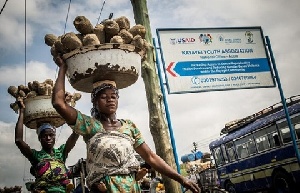 Ambitious young girls travel far away from the hinterlands to the cities to seek greener pastures
Ambitious young girls travel far away from the hinterlands to the cities to seek greener pastures
With the continuous increase in the number of female head porters, popularly known as ‘kayayei’, in the city, it is obvious that the struggle to curb rural-urban migration is not going to die out anytime soon in Ghana despite the numerous promises made by successive governments.
These days, it seems new sets of ambitious young girls travel far away from the hinterlands to the cities to seek greener pastures almost on a daily basis.
This is evident in the numerous young girls who turn to harass people in their bid to carry their goods.
In the past, you would find young women between the ages of 18 and 40 carrying loads to earn a living. The story is different now as girls as young as nine-year-olds are seen begging people to assist them to carry their loads for a fee.
Unfortunately, the demand for these kayayei is not so high; therefore, majority end up sleeping in the scorching sun all day in their head pans, on rags, cardboards or on the bare ground at the market centres, pedestrian walkways, lorry parks, among other places.
In Accra, places such as the Konkonba Market, Timber Market, Odorkor, Sodom and Gomorrah, Agbogbloshie Market, Mallam Attah Market, between Adjaben and Kantamanto, among others are the abode of these young girls.
The Mirror’s investigations show that these places are now known as ‘high class zones’ for those who have been in the system for a long while.
As a result of this, the new entrants are pitching camps around the Graphic Road, behind the Accra Technical University, Madina Market, Baatsona Market and Odawna Market.
Some of these teenagers are seen carrying pregnancies while others also have their children strapped to their backs while they struggle for space to lay their heads.
Early this year, the Minister of Gender, Children and Social Protection, Madam Otiko Afisah Djabah, made a pronouncement that the government was to eradicate the menace of kayayei in the country.
According to her, there were over 150,000 female head porters in the country; therefore, upon her approval as a minister, she would engage them in various vocational training programmes to sustain them financially as a measure towards alleviating poverty.
Regrettably, it has been almost a year now and most of these promises have not been fulfilled.
A report by the United Nations Population Fund (UNFPA) stated that the world was undergoing the largest wave of urban growth in history.
More than half of the world’s population now live in towns and cities and by 2030, this number will swell to about five billion. Much of this urbanisation will unfold in Africa and Asia, bringing huge social, economic and environmental transformations.
The report indicated that for many people, cities represent a world of new opportunities, including jobs. There is a powerful link between urbanisation and economic growth.
Around the world, towns and cities are responsible for over 80 per cent of gross national product. Urban poverty is growing around the world, and this is largely because many people – including the poor – are moving to urban areas.
“The opportunities there extend beyond just jobs. Cities also offer greater opportunities for social mobilisation and women’s empowerment. Many young people, especially young women, regard the move to cities as an opportunity to escape traditional patriarchy and experience new freedoms,” the report stated.
For most of these Kayayei, the urban areas also offer greater access to education and health services, including sexual and reproductive health care, further promoting women’s empowerment and the realisation of their reproductive rights.
Therefore, until conscious efforts are made to ensure that these young girls of school-going age remain in the rural areas to complete their education and gain employable skills, the menace of kayayei will forever remain with us especially when the tax burden on the Kayayei was abolished by this current government making the business more attractive to the young girls.